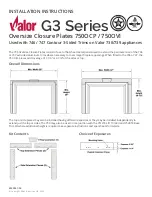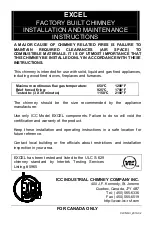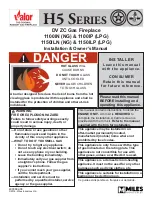
Harman 300i Wood Insert
11
For Installation In Masonry Fireplace Only
gaskets
Gaskets are used at strategic positions for controlling
the path that incoming and outgoing air and gases take
through the insert. You must check these gaskets from
time to time, and replace them when necessary. You
can test the seal by closing the component onto a piece
of paper. When closed, the paper should not pull out of
the seal without resistance. The gaskets are made of
fiberglass of different sizes (obtainable from your Harman
dealer) and are fixed in place with a high temperature
gasket cement. To change a gasket, first remove the worn
fiberglass and clean the area with a wire brush. Also
clean any other surfaces that come into contact with the
gasket. Place a small bead of cement in the area under the
gasket, then press new gasket material into the channel;
do not overlap the ends. Seat the gasket firmly by applying
pressure when possible; for example, after changing the
door gasket, close the door. Allow the cement to dry before
using your insert.
Gaskets are located on the door and between the
damper and the damper frame.
door latch
After a period of time, you may find that the front
door does not close as firmly as when your insert was
new. This is mostly due to a natural compression of
the gaskets. To adjust the latch, loosen the two bolts,
and bump
the retainer
back.
Adjust as
necessary
to acheive a
good seal.
Chimney System
C
reosote Formation And Need For removal
When wood is burned slowly, it produces tar and other
organic vapors, which combine with expelled moisture
to form creosote. The creosote vapors condense in the
relatively cool chimney flue of a slow burning fire. As a
result, creosote accumulates on the flue lining. When
ignited, this creosote makes an extremely hot fire.
The FireDome Combustion system cuts creosote to
almost nothing when properly burned with dry seasoned
wood.
The chimney connector and chimney should be
inspected at least once every 2 months during the heating
season to determine if a creosote buildup has occurred.
Checking your chimney and chimney connector more
frequently, especially while you are getting used to
your insert, is recommended. To inspect this system, let
the insert cool. Using a flashlight and mirror, check the
interior of the chimney connector, and the chimney itself.
If creosote has accumulated (3mm or more) it should be
removed to reduce the risk of a chimney fire.
To clean deposits from the surface of the connector,
open the bypass damper to prevent debris from falling
into the FireDome, and clean using the appropriate
brush. When cleaning the stainless steel connector, it is
recommended to use a non-metal brush.
To clean the chimney, use a specially designed
brush sized to fit your particular flue opening, or call an
established chimney cleaning service. It is recommended
that you have your chimney professionally cleaned and
inspected annually. Any cracks or damage should be
repaired before further use of the insert.
Occasionally, it will be necessary to remove the insert
to inspect the appliance and the fireplace. To remove
the insert, you will first need to remove the two bolts that
secure the flue adapter to the top of the insert. Slide the
insert out of the fireplace for inspection. Have any cracks
or damage repaired before further use of the insert.
Do not burn any fuel other than wood, such as charcoal,
which can cause increased carbon monoxide production
or overfiring. Never use highly volatile substances in your
insert, such as gasoline, which could cause an explosion.
When solid fuels are burned completely, they produce
water and carbon dioxide. However, in long slow burns, a
substantial amount of carbon monoxide may be produced.
If allowed to build up, carbon monoxide (which is odorless)
can prove fatally poisonous. Proper ventilation and draft
will prevent this from happening. If you smell smoke,
increase the air control lever setting, and thoroughly
ventilate your dwelling. During future burns, be careful not
to overload the insert with fuel, so you will not be tempted
to constantly operate at a low air control setting.
Other causes of poor draft are icing, exhaust fans, and
room air starvation, which may occur in tightly constructed
homes. If your insert is sluggish and you get an occasional
odor, check these possibilities and increase the air flow in
your home. Dryer vents and other appliances operating
in close proximity to the insert may also create negative
pressure.
Proper ventilation
Always provide a source of fresh air to the room when
the insert is operating.
blowers
The blowers on your insert require very little
maintenance. You should, however, keep the air inlets
and the motors and fan blades free of dust and pet hair.
Summary of Contents for 300i
Page 2: ......










































